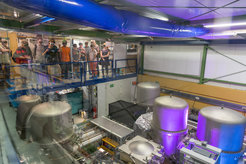Open Day at GEO600 on 31 July 2016
Visit the gravitational-wave detector near Sarstedt
On Sunday, 31 July 2016, the Max Planck Institute for Gravitational Physics and the Institute for Gravitational Physics of Leibniz Universität Hannover are inviting people to visit the Anglo-German gravitational wave detector GEO600 near Sarstedt. Between 11a.m. and 4p.m., researchers at the detector premises will give lectures on gravitational waves – which were only detected for the first time recently, opening up a completely new window to the universe. A think tank of international research, GEO600 played a crucial role here.
New astronomy with gravitational waves
Humankind has been looking at the stars since time immemorial, and over the centuries telescopes have become more and more powerful. However, these telescopes only allow a glimpse of our universe, with many objects being hidden or basically invisible.
With the first direct measurement of gravitational waves in September 2015, for the first time a new window offered a glimpse of the invisible “dark” side of the universe. GEO600 is playing an important role here, developing and testing new technologies for the detection of gravitational waves. These technologies are very important for the sensitivity of the advanced LIGO detectors in the US, which measured the gravitational waves.
Cutting-edge research at first hand

The Open Day on 31 July 2016, which will take place between 11a.m. and 4p.m., will give visitors first-hand information on the basic research and day-to-day work of the gravitational wave detector GEO600. Optional guided tours of the detector premises will provide an insight into the heart of the highly sensitive measurement facility, while the event itself will be rounded off with exhibits and the chance to attend brief talks and converse with scientists.
Gravitational waves – predicted by Einstein 100 years ago
With his general theory of relativity, Albert Einstein revolutionised our understanding of the universe in 1915. An important outcome of his theory is the existence of gravitational waves – tiny ripples in space – which he predicted back in 1916. These ripples occur in major cosmic events, such as star explosions, or when compact star remnants, such as black holes, merge with one another. Gravitational waves compress and expand space on their path through the universe, thus causing tiny elongations that – similar to sound waves in the air – represent the sound of the universe to a certain extent.
These ripples in space were detected by an international research team with the aid of the two advanced LIGO Laser Interferometers in September 2015. These interferometers carry out a highly precise comparison of two vertically running laser light beams. Even strong gravitational waves are only capable of changing the arm length by a fraction of the diameter of an atom – which is how precise the measurement of the advanced LIGO, GEO600 and Franco-Italian Virgo detectors are today.
GEO600 is jointly operated by the Max Planck Institute for Gravitational Physics in Hannover, the Leibniz Universität Hannover and research groups at the Universities of Cardiff and Glasgow. It is funded by the Federal Ministry of Education and Research, the Federal State of Lower Saxony, the Max Planck Society, the British Science & Technology Facilities Council and the Volkswagen Foundation.
Getting there by bike
The GEO600 premises are situated to the south of the Leine River and can be ideally reached by taking a slight detour from the “Grüner Ring” cycling route. A visit to GEO600 is best combined with a bike ride, as you can cycle directly to the central building of the GEO600. A bike map has been provided on the right column of this page for orientation purposes.
Travelling from Hannover by car and where to park
By car: Take the B6 (Messeschnellweg) southbound and take a right at “Sarstedt/Heisede”. Turn right in the direction of Heisede, then left at “Schulenburg/Ruthe”. In Ruthe, turn right. After the Leine crossing, turn right at the EXPO sign (or at the white sign for “Universität Hannover/Versuchsgelände” or the green sign for “Schäferberg”).
Please do not drive directly to the central building of GEO600. When travelling by car, please use the car park at the Lehr- und Forschungsgut Ruthe at the University of Veterinary Medicine Hannover (Tierärztliche Hochschule Hannover). You can park here at the manor house (see the map on the right) or at the poultry houses (located further down the road). From here, it is a short walk of about a kilometre to the central building of the gravitational wave observatory along the 600-metre laser measuring circuit of GEO600. You will find information boards along the path.













